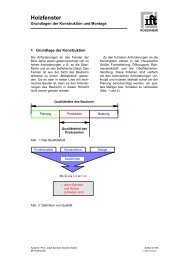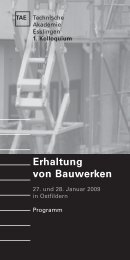Carbon fibre reinforced laminates Bonded steel ... - Siegwart, Michael
Carbon fibre reinforced laminates Bonded steel ... - Siegwart, Michael
Carbon fibre reinforced laminates Bonded steel ... - Siegwart, Michael
You also want an ePaper? Increase the reach of your titles
YUMPU automatically turns print PDFs into web optimized ePapers that Google loves.
UNIVERSITY OF ULSTER<br />
- Jordanstown -<br />
School of the Built Environment<br />
Background Knowledge<br />
in the concrete progresses. The shift of the points of contraflexure will stop near the end<br />
supports. At the end supports the conflicting forces of shear and flexure causes the<br />
reinforcement to kink. The maximum load-carrying capacity of the concrete is reached when<br />
small parts of concrete in the compression corners of the beam crush.<br />
REPAIR OF CONCRETE STRUCTURES<br />
Although concrete is a material which provides high durability and resistance against<br />
aggressive environmental factors, concrete structures undergo some damage due to physical<br />
impact or environmental attack and therefore need to be repaired. Damage might occur<br />
because of the following reasons: cracks in concrete, high permeability or high porosity,<br />
insufficient cover, carbonation and chloride, abrasion, freeze thaw, thermal shock, fire<br />
damage, high velocity waters, overloading, chemical reactions and alkali-silica reaction.<br />
Two basic types of repair work can be classified. The structural repair and the non-structural<br />
repair (Figure 11). The aim of any concrete repair is to protect the reinforcement from further<br />
corrosion, to enhance or restore the appearance of the structure, and to restore or increase the<br />
load carrying capacity. The selected repair method must provide durable repair within an<br />
acceptable cost range.<br />
Deep cracks in massive concrete members and cracks, which pass through a member, can be<br />
repaired by crack injection using a selected polymer such as epoxy resin. It is very important<br />
that the work is carried out carefully since inadequately repaired cracks cannot be repaired for<br />
a second time. Once epoxy has filled the cracks, it will rest there and cannot be removed any<br />
more. The resin is suitable to restore the structure to its original strength and stiffness [1] .<br />
The strengthening of beams by means of epoxy-bonded <strong>steel</strong> or composite plates is widely<br />
used. A major shortcoming of the system is the corrosion of the plates since the surface is<br />
fully exposed to the environment. An alternative to <strong>steel</strong> plates is therefore the bonding of<br />
<strong>reinforced</strong> plastics, which do not corrode. Other basic advantages are their low weight, which<br />
makes installation very easy and their greater length since the need for lapping at joints is<br />
eliminated. The material can be pre-stressed [20] and is fire resistant. [11] . On the other hand the<br />
material is relatively costly compared to <strong>steel</strong>.<br />
<strong>Michael</strong> <strong>Siegwart</strong> 3











